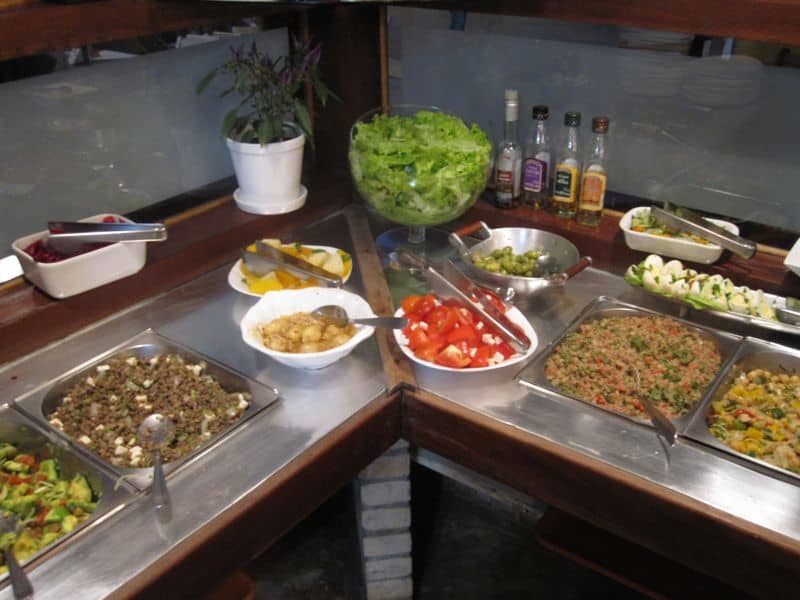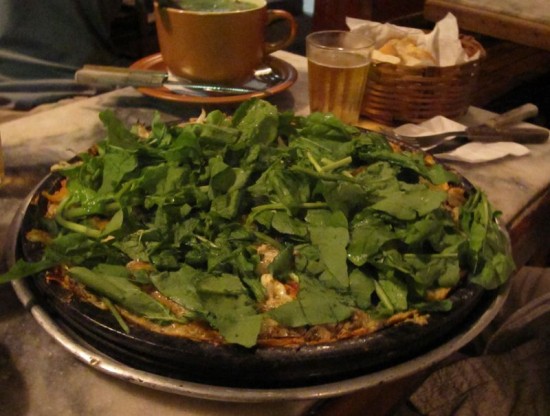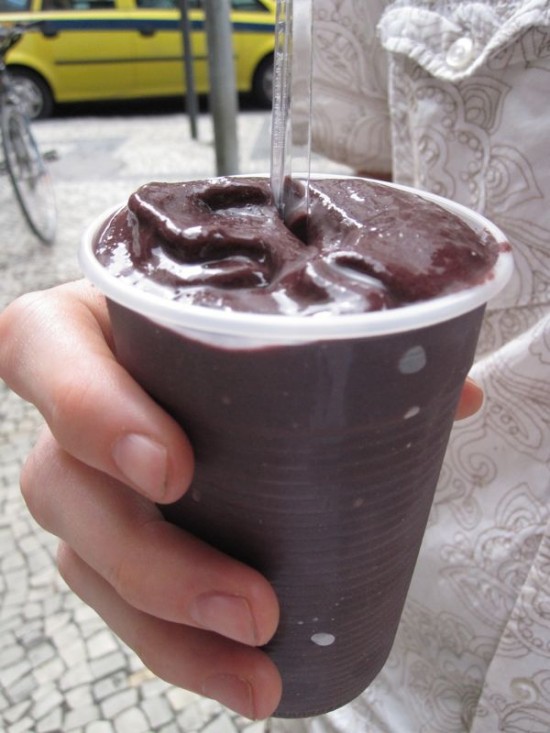This page contains affiliate links. Please read our disclosure for more info.
South America is not going to be an easy place for two vegetarians who like their food, so during our travels we’ll be investigating the best meat-free options and creating a Vegetarian Survival Guide for each country we visit.
Brazil is as meat orientated as the rest of the continent, and has the additional problem of being quite expensive for budget travellers. We found that most cheap restaurants don’t have any vegetarian options at all, as the set meals consist of meat, chicken or fish served with rice, beans and salad.
We managed to survive though, and without blowing the budget too much. Here are our recommendations for vegetarians visiting Brazil.
Learn Some Portuguese
English is not widely spoken so it’s vital to learn some Brazilian Portuguese phrases. We found the Lonely Planet Brazilian Portuguese Phrasebook useful with a fairly extensive menu reader and some basic vegetarian phrases. Portuguese pronunciation is tricky though so it’s worth doing an audio course as well.
You could try telling people “Eu sou vegetariano” (I am a vegetarian), but this often won’t mean anything to them so it’s best to be more specific:
“Eu não como carne, peixe ou frango” (I don’t eat meat, fish or poultry).
Por Kilo Restaurants
Por kilo restaurants were our saviour. They are self service buffet style restaurants where you help yourself and then pay by weight (take your plate up to be weighed before sitting down). They are found everywhere in Brazil, even in small towns, and are one of the cheapest options for eating out. Although they offer plenty of meat we could always find salad, chips, rice and often pasta. The quality of labelling varies so you’ll need to ask if you aren’t sure what something is (this is where the Portuguese comes in).
Our absolute favourite por kilo restaurant was on Ilha Grande off the coast of the state of Rio. Biergarten (Av. Getúlio Vargas 161, Abraão) has plenty of fresh, tasty, well-labelled vegetarian options including interesting salads, pastas, vegetable bakes and mashed potatoes. It’s a definite cut above the rest.
New Natural in Ipanema (Rua Barão da Torre 173) is another above-average self service restaurant with good vegetarian choices.
Cost: 10 – 15 reais depending on the restaurant and how much you eat.
Pizza
We ate a lot of pizza as it is easy to find and is usually decent. It isn’t ultra cheap but if you share it can be reasonable. Good vegetarian toppings to look out for are tomate seco (sun dried tomatoes), rucola (rocket), berenjela (aubergine/eggplant), palmito (palm heart), and cebolla (onion).
We enjoyed the pizzas at Pizza na Praça on Ilha Grande and at the bars in Largo das Neves, a lovely square in Santa Teresa, Rio de Janeiro.
Cost: 20-30 reais for medium- large size.
Snacks (Salgados)
Savoury deep-fried pastries known as pastels are everywhere but it can be hard to find vegetarian fillings. The most you can hope for is queijo (cheese), but this isn’t always available.
Pastels are rarely labelled so you´ll need to try out your Portuguese and ask if they have anything without meat or fish/ with only cheese: “Tem alguma coisa sem carne ou peixe/ com so queijo?“. Remember that it’s always worth breaking open your pastel before biting in, just in case.
Another useful veggie snack is Pão de Queijo – small cheese bread balls that are common in Brazil.
Cost: About 3 reais.
Fill Up at Breakfast
Most hotels and hostels in Brazil provide really good breakfasts for free. Even if you avoid the ham there are still options for vegetarians including good fresh bread rolls, cheese, jams, tropical fruit and juices, and sometimes cake. Make the most of it and fill yourself up for the rest of the day.
Cost: Free.
Fresh Fruit
One of the best things about Brazil is the huge range of tropical fruit, and especially the fresh juices (sucos). Juice bars are found on most corners and are the cheapest place to sample a refreshing beverage. Orange (laranja), passion-fruit (maracujá), mango (manga), guava (goiaba), kiwi (kiwi), pineapple (abacaxí), papaya (mamão), lime (limão), cashew fruit (cajú) and melon (melão) are all gorgeous.
Best of all is açai – a purple palm tree berry native to Brazil that is supposed to be very nutritious. We’d never come across it before but quickly became huge fans. Mixed with ice it’s very refreshing, and locals often eat the thick mixture with a spoon from a bowl with banana, granola and other toppings.
You can also enjoy fruit juices mixed with the local brew cachaça to create the national cocktail caipirinha. It is most commonly mixed with lime juice, but other fruity flavours are available.
Cost: 2.50 reais in a juice bar, 4 reais in a bar or restaurant. At least double that for a caipirinha (the cheapest are found at street stalls).
Ice-Cream
It may not be healthy but the wonderful Brazilian ice-cream is the perfect antidote to a disappointing vegetarian meal. Sorveterias (ice cream parlours) are common, but our favourite is on Ilha Grande, next to the ferry terminal in Abraão. There are over 30 flavours which you are free to sample, before helping yourself to a cone or bowl full and choosing your toppings. Take your creation to the till and pay by weight (of course, this is Brazil).
As with pizza we are very grateful for the Italian influence in Brazil!
Cost: It depends on how much you have but two scoops were usually about 3.50 reais.
Resources
For a list of vegetarian restaurants and health food shops in Brazil visit Happy Cow.
Please note that this is based on our 2.5 weeks in Brazil where we only visited the state of Rio de Janeiro. Things could vary in other parts of this huge country.





Hi folks,i’m sorry to inform you that all cheeses in Brazil are made with rennet (the portuguese word for animal rennet is ‘coalho’ ) usually made from mashed up intestines of sheep or lamb.Rennet coagulates the milk curd to make cheese.When you look closely at your pizza or cheese on toast you will see a clear layer of something on the top,that is the animal fat.Vegetarian cheese is made from vegetable rennet and as far as i know only available in a couple of countries in europe, the u.k…..and,of course america,which is where i think it was conceived….sorry……Baz
Thanks for that info, I did want to know what I am eating.
I am in quarantine for a week in the Raddison in Rio, a precaution before going offshore.
I can not leave the room and the attitude of the staff here is literally sighing with inconvenience when I try an get food. Totally depressed by the whole experience.
If I were the Raddison chain CEO I would remove the Name Raddison from them.
I only want to eat. We do struggle some times ?
Hmmm… I love the “create you own ice-cream” idea :)
Botafogo and Centro are really the neighbourhoods to eat if you are a vegetarian in Rio (aka I’m a vegetarian from Rio). There are also a lot of South East Asian food. I love Thai, so that is an important information. There are three big chains called “Balada Mix”, “Delírio Tropical” and “Doce delícia” that sell a lot of organic, salads and vegetarian(!) food. Bar foods that are great for vegetarians and cheap: pastéis (queijo) or look for Bar do Adão that has a crazy variety of pastéis and they are really nice, feijão amigo (friendly beans) just ask without “tocinho” or bacon, which they would usually bring on the side. And in a lot of bars they will sell “caldo verde”, which can be roughly translated as green chowder. It’s not a good idea to order it, it is usually filled with paio (pork).
Muita obrigada Simon and everyone who posted! I am going back to Brazil for the first time in 15yrs for the World Cup in less than a month and was expecting to have to ration energy bars brought from the US since I’m a vegan!
The last time I visited when I was 10 I was vegetarian and the family I stayed with was very accommodating, but I’m not expecting such lavish treatment this time around and and so grateful to have these resources to draw from on my trip. I’ll be sure to post about my finds when I’m there!
Hi! I’m from Rio anda now a days there are more vegan restaurantes around here.
getting vegeterian food in india is not at all problem
Thanks for the article,
so far I have not been able to find vegetarian beans! Mostly I cook, but when travelling/on the road it is usefull to just have a plte of rice and beans and salad, like in other latin countries I have visited. These beans -or lentils had very rarely meat in them.
In brazil, they seem to believe that beans NEED to have pieces of meat.. Even in the vegetarian restaurant I went to (10 reais for a ful, course), the beans had pieces of soy meat in them…
Best bean country: Guatemala….
Jana, black beans with meat is a typical brazilian dish called FEIJOADA.
The vegan style is made with soy meat, seitan, tempeh… all mixed.
thank you for this bit of information on vegan/vegetarian places i was getting worried that i would be starving. this so helpful
Pão de queijo isn’t vegetarian. It’s made with a cheese called queijo coalho which literally means rennet cheese. Brazilian food is very boring. Bland. They don’t even have pepper on the table!
go north in Brazil that you wil find pepper in the table =)
I’m sorry you had a less than great vegetarian experience in Rio de Janeiro, but there are many vegetarian and vegetarian friendly restaurants there.
I can confirm what you said. I’m brasilian, carioca and I’m a vegan without exceptions. I live in Rio de Janeiro, In the city center and south area has some vegetarians/vegans restaurants. Not is dificult find places like this. The markets also sell animal-free food.
I’m a vegan for more than 3 years in Rio and I can eat vegan food without problems.
Sorry for my poor english.
Here’s a great tip for tourists (vegan or not) going to Rio! I made a video about Confeitaria Colombo, a super elegant and delicious pastry in downtown Rio, were you there? Here is the link if you’d like to take a look!
Thanks for the tips on Brazil. It’s certainly high on the list of destinations. I have heard about difficulties in getting vego food there, but it sounds like you can survive!
Thank you so much for this post, it has very useful tips! I’m going back to Brazil at the end of this year to see family, only I’ve become a vegetarian since I left ten years ago. I’m explaining to them over email what being a vegetarian means, so hopefully by the time I get there they will be prepared. If worst comes to worst, I can always buy tofu at the supermarket (I hope) and cook myself. I’m privileged to have family there who love me (and also have money, so can afford to feed me!) so hopefully I will survive.
On a more important note – seeing that picture of acai makes me VERY FRUSTRATED because I am VERY JEALOUS. Dang it, ten years without my favourite food is killing me slowly. I am craving acai so much!!! D:
Thanks again for the post! :)
If you have access to a kitchen you’ll be fine. Brazil definitely wasn’t the worst country for vegetarians we visited in South America. We miss acai too!
Does anyone know whether the various breads commonly available are made using lard?
I’m afraid I don’t know.
[I live in Rio] Most of the times they are not, specially the plain bread roll/baguette, but this can change on supermarkets or other non-chain stores depending on the staff making the bread…. sorry. If you can manage to learn some Portuguese before coming, try to ask before or look for “banha” / “banho de porco” (lard / pork lard, pronounces bahn-ya) on the ingredients list. If you’re looking for vegan bread options, stick with the common bagette as normally every other bread has some sort of milk of egg ingredients in them.
As a side note, Rio now has a ton of new vegetarian and vegan restaurants spreading from Zona Sul through Centro, making it much easier to eat now! (though prices [everywhere] have risen a lot since the World Cup/Olympics). I recommend Vegan Vegan in Botafogo and Dona Vegana in Centro. São Paulo remains as the best place in Brazil (I’ve heard even in South America) to eat vegetarian and vegan (you should really check Prime Dog’s vegetarian and vegan options there).
Hello,
I´m sorry to report that the cost of a meal in a kilo place is already between 20 and 25, for a decently filled dish.
Prices here are soaring. It´s more and more difficult to find a decent quality veggie budget place to eat…. (New Natural is still a good option)
Living here, I should prepare a list to help you guys!!
Sorry to hear prices are rising – we found it expensive enough when we were there two years ago!
Pão de Queijo is the best!!
Me ha parecido muy interesante el contenido de este artículo.
Que buena, además, la foto de la pizza.
There you go! A guide to the best vegetarian restaurants in SP. It’s in Portuguese but it’s easy to find out names and adds. Enjoy!
Obrigada!
I wish that I had read this post before I went to Brasil 4 months ago, but I’m going again in 2 weeks, so it was nice to get a refresher course. I didn’t have too much trouble being a veggie there, nor in Argentina. So many awesome pastas, breads, veggies, fruits, etc. I become addicted to acai. I’m drooling thinking about it! And I loved the por kilo restaurants as well! Found a great one in Rio.
.-= Andi´s last blog ..imgp2629 =-.
Your suggestions are good ones. In the southern areas of Sao Paulo and farther south, there are lots of Italian restaurants or ones that serve pasta and other Italian food per kilo. Also, Sao Paulo has lots of excellent vegetarian restaurants! In a pinch, a typical Brazilian meal of beans (look for the ones w/o meat) and rice with kale, farofa, and a small salad is a decent meal.
.-= Jenna´s last blog ..Florence: 5 not-quite-as-touristy things =-.
Thanks for the tips Jenna.
Just wondering, have you found it difficult to eat only vegetarian food while traveling in Brazil and Argentina? A friend of mine traveled in Brazil, mostly in the north, and was frustrated by the lack of options. I don’t think it’s much better here in the U.S., to be honest. :-)
.-= Jenna´s last blog ..Do You Know? #6 =-.
We did find it a bit tricky in Brazil to be honest. We could always eat but we just didn´t have that many options so it got boring after a while. So far we have only visited Buenos Aires in Argentina and it´s MUCH better here. There are some gorgeous veggie restaurants (reviews coming soon!) so if you plan ahead you can eat very well. In normal restaurants pizza and some good homemade pasta are the best options. It´s cheaper here than in Brazil too.
Yikes, Jenna – I have been traveling to Brazil 2x monthly since January and I have to say the veg options are harder to find here than in CA! By far. Apart from the fabulous variety (and availability) of the fruits here, the food is lackluster. Beef, rice, and potatoes, little seasoning, no dimension…boring and oriented to the carnivore.
I stuck with the all-you-can-eat restaurants in Argentina as well because at least you can walk in and actually have a look at the food being offered before deciding to eat there. There were quite a few instances when I would order pasta or a salad at a normal restaurant and sure enough, it would come mixed with some sort of beef even though it wasn’t on the menu!
.-= Earl´s last blog ..My Asylum From The Insanity Of Travel =-.
Yeah that’s always a risk. We ordered a cheese & tomato empanada yesterday but it turned out to have ham in it. We are trying not to worry about stuff like this though, as it won’t be the last time.
Excellent write up!! I love Brazil – always ate really well there! The rice, beans and salad option was always so wonderfully prepared that I would be very happy to eat just that – but the per kilo restaurants always kept me full on other options :)
I also recommend the rodízio (all you can eat) restaurants. There are a lot of Italian ones so you get a wide selection of pastas and pizzas and it’s usually extremely inexpensive, especially if you have a big appetite :D They tend to have wide variations that work out great for veggies!
Although in Rio Grande do Sul (Porto Alegre for example) it’s much harder as they are as bad as the Argentines in having an obsession for beef! Luckily, Brazilians are extremely accommodating and always make sure you are happy. I ate in villages in the countryside never used to foreigners and still had no worries and ate better than I have in Europe (although speaking Portuguese made a huge difference)
By the way, you may also enjoy my travelling veggie tips. I mentioned some tips about Argentina in there ;)
I ate at Biergarten too!!! Loved it :D :D Small world!
Thanks for the tips Benny and we´re impressed you managed to eat well even in rural areas. Speaking the local language is a definite advantage, especially for vegetarians. Italian food is generally our saviour everywhere.
Your travelling vegetarian post is really useful – we´ll look out for the ´dieta´sections of menus here in Buenos Aires. So far we´ve found that veggie restaurants never say that they are, but describe themselves as ‘natural’ or ‘organico’.
I’m from Porto Alegre, and I’m a vegan! There are some vegan/vegetarian restaurants in Porto Alegre, and it’s not that hard to give up meat here. Today tofu and soy protein are easy to find, plus lots of fruits, seeds, green leafs, etc. But things get much harder when you go to the countryside… although there are lots of potatoes, fruits and cassava roots, people in Rio Grande do Sul rural areas are seriously obsessed with barbecue :/
That’s great to know -thank you!
I just finished watching a video on factory farm animal cruelty, it has torn my heart to pieces. I want to try to become a vegan disregarding how much I love/loved the taste of meat. I have been living in Porto Alegre for just over a month now. Could you guide me on where I can find vegan restaurants and also what foods to get.
Would appreciate a response even though this page is a few years old.
Kind regards,